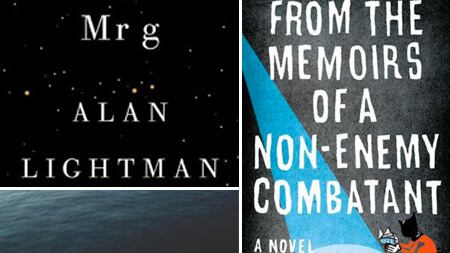The Art of Mourning Gracefully

A few years after the grisly discovery of her toddler son’s maimed and mauled body, Anne Morrow Lindbergh, the wife of famed aviator Charles Lindbergh, wrote in her journal that “contrary to the general assumption, the first days of grief are not the worst ... After shock comes acute early grief which is a kind of ‘condensed presence’—almost a form of possession. One still feels the lost limb down to the nerve endings. It is as if the intensity of grief fused the distance between you and the dead.” Joan Didion, literature’s current arbiter of all things melancholy, had a similar response in her new memoir Blue Nights, in which she chronicled the sorrows of outliving her entire family. Yet, inexplicably, the common understanding is that grief diffuses over time, that because “grief comes to you all at once ... you think it will be over all at once.” There is a lingering disconnect between the reality of grief and the human perception of it. Somehow, despite its universality and inevitability, deep, prolonged mourning remains the most misunderstood human emotion.
In Making Toast, published in 2010, Roger Rosenblatt explored the first year of life without his daughter Amy, who died suddenly of an undiagnosed heart problem at the age of 38. Despite its heartbreaking subject matter—Amy left behind three young children, whom Rosenblatt and his wife now help care for—the memoir never felt treacley or indulgent. Instead, Rosenblatt’s evocations on life after tragedy exuded hope and possibility. Now, in Kayak Morning, another memoir of life without Amy, Rosenblatt turns a darker, more inward eye and focuses on the unexpected sorrow that takes root after shock and disbelief drift away. If Making Toast was a tale of familial recovery, Kayak Morning is a warning of the unexpected endurance of heartache, an evocation that confirms the verity of Didion and Lindbergh’s suspended emotional states.
More a collection than a narrative, Kayak Morning’s loose, woven structure includes bits of biography, disembodied conversations, fragments of famous mourning poetry, and most heavily, Rosenblatt’s musings on his time spent kayaking. It is a form that suits the memoir’s content. After all, grief itself is messy and convoluted, a state of mind that cannot easily be converted into a linear formation. A straightforward narrative would perhaps do a disservice to the intricacies of grief—the sudden stops, diversions, and rerouting of thoughts are what separate, and often isolate, the sorrow-stricken brain. For Rosenblatt, that isolation separates him even from his closest family, those who also mourn the loss of Amy. Morning in his kayak is the only time when Rosenblatt’s isolation produces a tiny bit of clarity.
Kayaking certainly proves a compelling metaphor for both writing and grief. Like writing, kayaking is all a balancing act, a one-man show of force and skill. And like grief, kayaking is something we must conquer alone; it requires strength of mind and body, along with pure force and willingness—grief is not an emotion to be mastered overnight. Rosenblatt’s gradual evolution as a grieving father parallels his introduction to the world of the creek, and he masterfully renders both aspects as continual works in progress: one never ceases to be in mourning, just as one never ceases to wonder at the bounties of nature.
In this sense, Kayak Morning itself is both an exercise and a product. After talking it over with a therapist friend, Rosenblatt initially protests against the idea of speaking directly to Amy. His anger over her death (which movingly spills out every dozen pages or so) overrides his desire to “move on” from her death. Instead, he desperately clings to his anger and sense of injustice; after all, remaining attached to a death is a way of remaining attached to a life. But Rosenblatt uses his writing, as he has done for many years, to slowly explicate and enumerate his feelings, eventually letting go of some of that anger, and offering the book itself as a testimony to Amy. The result is a graceful investigation into the cathartic possibilities of writing itself. “There’s only one point to writing,” Rosenblatt says. “It allows you to do impossible things.” And what greater impossibility exists than moving on after the death of a child?
In this sweet, compelling little book, Rosenblatt joins the likes of Mary Shelley, David Grossman, Victor Hugo, Mark Twain, and Charles Darwin—he has lost a child and taken up his pen to combat the sorrow. But luckily for his readers, Rosenblatt never goes to war against his emotions. Instead, as best anyone can, he gracefully renders them visceral. Rosenblatt never assumes to have conquered or understood his grief; he simply transcribes it, noting its aberrations and intricacies. This book cannot fix me or you, he seems to say, but it can accompany you, make you feel a bit less alone. And so while Rosenblatt’s subject is not new or original, it is, sadly, a human necessity.—Hillary Kelly
In the Beginning …

Alan Lightman is a best-selling novelist as well as a distinguished scientist; for many years, he taught both physics and writing at MIT. In his latest novel, Mr. g, Lightman spins a playful but reverent story about the creation of the universe from the perspective of its creator.
Because this is a scientist’s creation myth, it elegantly adheres to the laws of physics. After inventing time, Mr. g uses precise exponents to measure its passage. Mr. g brings electrons, muons, taus, quarks, squarks, gravitrons, photons, and neutrinos into being and marks the time as they coalesce into larger particles, creating atoms, molecules, and elements. The divine magic of this creation is science itself.
For a book with no hidden plot twists—the reader knows that Mr. g’s experiments in cosmos-building in his pet universe, Aalam-104729, are bound to lead to the birth of mankind—Mr. g is strangely suspenseful. It turns out that the act of creation is profoundly transformative, even for a formless, timeless, all-powerful primogenitor. The plot moves forward as the universe gradually unfolds, but the real story here is about Mr. g’s inner awakening. Mr. g is an eminent scientist and artist, but, essentially alone and unchallenged in the eternal folds of the Void, he’s had little occasion to test his mettle as a philosopher or poet. Contemplating the thrumming, whirling galaxies, stars and planets he’s created, Mr. g is, perhaps for the first time, moved:
I felt that my imagination had been amplified and enlarged. I felt that I knew things I hadn’t known before, and I felt larger than before. How was it possible that something I’d created from my own being was now larger than my being? Is it possible that the created can create its creator? I was baffled and pleased at the same time.
Despite Lightman’s numerous cross-cultural references—Alaam, for example, is an Arabic word for “universe”—the basic portrait of the creator that emerges in this novel is one that will be largely familiar to most Western readers. Though he displays a vulnerability and inquisitiveness not typically associated with omnipotence, Mr. g is in the end a solitary, masculine, and relatively humorless figure. Mr. g’s bafflement and tenderness for his creation are his most endearing and original qualities.
They’re also what save the book from being merely clever. When not diffusing spats between his Aunt Penelope and Uncle Deva (two thinly drawn characters who share the Void with Mr. g, and occasionally pause from their squabbles to offer him advice), Mr g. spends his days deep in thought, or in debate with a shady figure known simply as Belhor. Belhor lives in a “magnificent floating castle” adorned with “parapets carved with strange symbols.” He also has a taste for dark fugues, nocturnes, and symphonies of melancholia. A typical conversation between them goes something like this: “I admire your compassion,” Belhor tells Mr g. “But I want to suggest that evil, maliciousness, greed, deceit, while being unfortunate, are in fact necessary.”
Mr. g’s debates with Belhor tackle weighty theological topics, but they’re drawn lightly and end inconclusively. The only commandments of Mr. g’s authorship are the laws of physics; still, he loves beauty and goodness and is pained to see the creatures he’s created endure suffering and one another’s cruelty. Lightman hints that in the face of the universe’s wondrous complexity and tremendous capacity for chaos, even an all-powerful creator may be humbled. Perhaps Mr. g deserves the compassion of the mere mortals he created. Perhaps creating the universe is itself an act of faith.
—Mythili G. Rao
Gitmo Satire’s Strange Reality

Novelists like to congratulate themselves for their research; time spent in Google’s far-flung quadrants is worn as a badge of authenticity. But some novels leave more to invention than others, often by necessity. Alex Gilvarry’s strange hybrid of a book is one.
“They don’t know allow novelists in Guantánamo Bay,” Gilvarry said, provoking laughter from the capacity crowd attending his book-release party last month at The Strand’s rare-books room.
Gilvarry, who is 30 and a few inches past six feet, is the author of From the Memoirs of a Non-Enemy Combatant. His debut novel tells the story of Boyet (“Boy”) Hernandez, a five-foot-one-inch Filipino immigrant who, after attaining an evanescent fame as a fashion designer in New York, is shipped off to Guantánamo Bay for his alleged connection to terrorists. The book is, unsurprisingly, a satire—no other genre could encompass two such divergent topics.
Combatant’s peculiar cocktail of themes—immigrant on the make, post-9/11 burlesque, sybaritic send-up of fashion and hipster Brooklyn—goes down smoothly because Gilvarry writes with authority, if often with tongue firmly in cheek. “I did as much research on fashion as I did on Guantánamo, which is ridiculous,” he said.
Indeed, while Boy’s tale runneth over with references to Diane von Furstenberg and Oscar de La Renta (whose “immigrant narratives” the fashion aspirant devoured while growing up in the Philippines), it’s equally replete with touchstones from the war on terrorism and the post-9/11 security state. A publicist named Ben Laden (no relation) is detained by airport police “because of ‘homophonic similarities,’ ” causing him to miss a runway show. The copy of the Quran that Boy receives in “No Man’s Land”—his word for Gitmo—was previously owned by David Hicks, an Australian detainee who was released to his home country in April 2007.
Other references come from forgotten annals of pop culture—there’s a Lou Diamond Phillips sighting—or appear as coded versions of familiar American archetypes. There’s a self-aggrandizing pop star named Chloë, whose music promotes a kind of aggressively sultry chastity (her album is called Blueballer). We encounter familiar political iconography, as when Sheriff Michaels—a Shepard Fairey-like artist—superimposes a leaked photo of the imprisoned Boy with “damp shades of red, white, and blue” and stamps the word “BEHAVE at the foot of the image.” The poster becomes a sensation, emblematizing Boy’s plight.
It’s this facility with pop culture and with deconstructing its avatars that adds a layer of piquancy to Gilvarry’s satire. Like 30 Rock at its most gleefully savage, Gilvarry is capable of summoning just the proper reference—usually packaged in a zippy bon mot—to dress down his target. Explaining his lack of curiosity about others, Boy’s publicist, whose original surname was McLaden, says, “I don’t investigate where things come from, Boy. I was brought up Irish Catholic.”
At the book party, Gilvarry read from a chapter where Boy meets Ahmed, his new neighbor, future benefactor, and possible accomplice. Jokes about Corcoran, the real-estate behemoth that has played a major role in the gentrification of Brooklyn, earned laughs and knowing nods.
John Buffalo Mailer, son of Norman, had introduced Gilvarry. Echoing his father—chesty and bombastic—Mailer declared, “Alex Gilvarry has balls”—which was his way of saying that he admired the young author for committing himself not only to writing a political novel, but to a satirical one about a polarizing issue.
Gilvarry told me that the special responsibility of writing about Guantánamo weighed on him, and contributed to his decision not to use the place name itself—it was too loaded. “I knew I needed not to use that term at all,” he said. Boy’s own perceptions are similarly shrouded in metaphor: he refers to his arrest, obliquely, as “the Overwhelming Event.”
As compensation, Gilvarry seeded the text—which is nominally Boy’s confession—with footnotes from a fictional editor. This character isn’t a terrorism scholar or political commentator but rather Gil Johannessen, a journalist for W magazine. In an exquisite bit of pretension, Johannessen calls Boy’s fashion line “a Bildungsroman.” Of course, the young designer loves it and later trusts Johannessen with his story.
Lightly dispersed throughout the novel, Johannessen’s footnotes contribute to the sense of this story being grounded in our perverse reality. The footnotes offer corrections to Boy’s narrative, which is full of mistakes about proper names and basic matters of the law. They also provide information about real Gitmo detainees. Gilvarry explained that he wanted “to get people thinking about the issue, perhaps people who don’t know who these men are.” The footnotes allowed Gilvarry to create a factual parallel text, but it’s subdued enough to avoid becoming pedantic. Still, the balance is a precious one, illustrating that these are volatile ingredients; righteous indignation easily curdles into sanctimony.
Following the reading, the National Book Award-winning novelist Colum McCann, who taught Gilvarry in Hunter College’s M.F.A. program, joined his protégé and ribbed him with a few questions.
“We had a good time working on this,” McCann said. “Better for you,” Gilvarry quipped back, before going into a story about how McCann cut the novel’s first 30 pages to two.
Gilvarry joked that James Cameron wanted to film the movie adaptation and that James Franco would star as the diminutive Boy. “You made me have coffee with” Franco, Gilvarry said to McCann. “Now he doesn’t return my calls.”
It was a cheering bit of bonhomie and it reflected the evening and the book alike: a series of rapid shifts between the serious and the absurd, often landing in a place that was a murky mix between reality and fiction—the two can no longer be told apart. (Franco himself is the Zelig of the literary world these days.) But this is arguably the dominant cultural paradigm of the last decade, a period that evenly parallels Guantánamo’s time as a prison. (Gilvarry’s novel was released on Gitmo’s 10th anniversary.)
Ours is now a culture that overflows with the absurd, to the point where it substitutes for reality. Our greatest political commentator is a fake conservative TV host, campaign activist, and possible presidential candidate. Our most incisive newspaper is one whose fake headlines are so bizarrely possible as to often anticipate some future eventuality. “Onion headline or real?” is practically a catchphrase now.
It’s not false praise then to say that From the Memoirs of a Non-Enemy Combatant anticipates our reality. Six months ago, for someone like Boy to be arrested in New York and rendered to Gitmo would have seemed exceedingly unlikely. With the recent legalization of indefinite detention, such a scenario seems eminently plausible. It’s “very frightening,” Gilvarry said, commenting on the recent passage of the NDAA.
A satirical novel may no longer reach its release date before reality catches up with it. About Boy’s own story, Gilvarry told me, “It can happen. It can happen to anybody. They say that it won’t … we’ll see. It concerns me very much. It concerns all of us.”
—Jacob Silverman








